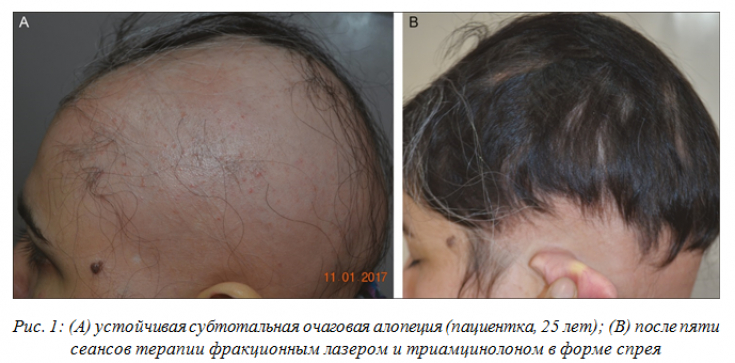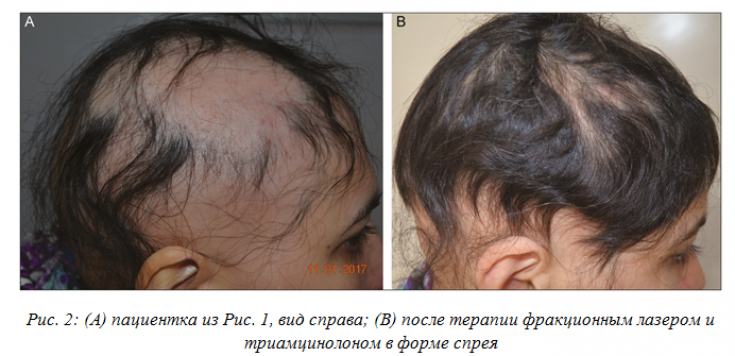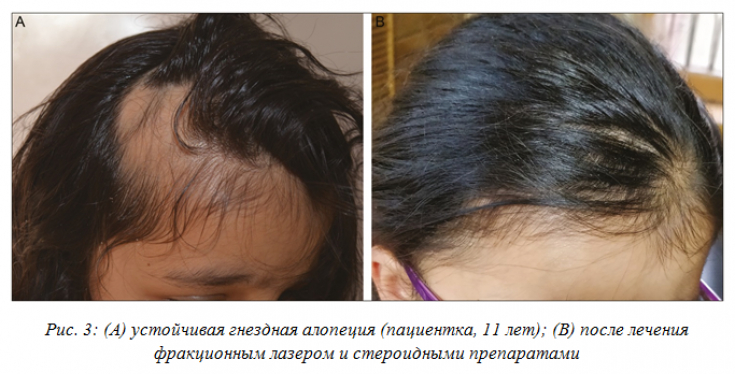Alopecia areata – a chronic inflammatory disease that leads to hair loss without scarring and can affect the scalp, beard, eyebrows and eyelashes, and also be generalized. The etiology of alopecia areata is unknown, but it is considered to be an autoimmune disease with a genetic predisposition.
The disease can develop in patients of all age groups, regardless of gender. In this article, estet-portal.com cites cases of treatment of alopecia areata with a fractional CO2 laser and topical corticosteroids.
What is the effect of fractional laser therapy in the treatment of alopecia areata
It is believed that the stimulation of hair growth under the influence of fractional laser therapy is due to the heating of the skin. In addition to the direct therapeutic effect, fractional lasers also provide transepidermal delivery of topical steroids to the hair follicles. This property of fractional laser devices is used to treat various dermatological problems such as burn scars, malignant neoplasms on the skin and even inflammatory skin diseases such as lichen planus.
Follow us on Instagram!
Microthermal zones created by fractional lasers form channels for uniform and controlled drug delivery. Uniform distribution of channels over the target zone causes uniform distribution of drugs in the dermis at a depth of 2-3 mm, where the dermal papillae and capillaries are located, which surround the cells of the hair follicle matrix.
The effect of fractional laser is believed to be due to stimulation of T-cell apoptosis, improved blood flow and accelerated transition of the telogen phase to the anagen phase.

The direct therapeutic effect of fractional laser in combination with transepidremal drug delivery to targeted hair follicles explains the synergistic effect of fractional laser and topical triamcinolone used in this study. Both of the above mechanisms may be responsible for hair regrowth in alopecia areata.
The delivery of corticosteroids using a fractional laser in the treatment of resistant forms of alopecia areata – new concept in dermatology.
When using a fractional CO2 laser as a transepidermal delivery system, triamcinolone is distributed more homogeneously in the target area than when using injection techniques. Moreover, this method avoids the pain associated with multiple punctures during intradermal injections. Another advantage of the described therapy is the reduced risk of skin atrophy when using topical triamcinolone.
Treatment of alopecia areata: study summary
This study included 10 patients with persistent alopecia areata of the scalp, beard and eyebrows who received combined therapy with a fractional CO2 laser and topical corticosteroids.
Evaluation of the effectiveness of the treatment was carried out by clinical examination and digital images during each treatment session.

The degree of clinical improvement was assessed as follows:
• great – hair regrowth >75%;
• good – hair regrowth 50–75%;
• satisfactory – hair regrowth 25–49%;
• unsatisfactory – hair regrowth <25%.
Fractional Laser Therapy + Topical Corticosteroids: Procedure Protocol
Topical anesthesia was applied to the target areas before the start of the procedure – euretic blend of lignocaine and prilocaine (Dolocaine, Cadila Pharmaceuticals, Mumbai, India). After 45-60 minutes, the skin areas were cleansed with 70% ethanol, and then – saline.
During therapy, a fractional CO2 laser (eCO2 from Lutronics, Korea) was used with the following parameters:
• ablative mode;
• 120 µm tip;
• flow density – 50–60mJ/cm2;
• density 100 microthermal zones (MTZ)/cm2.

The above parameters provide optimal transepidermal delivery of topical steroids to the dermis.
Affected areas treated with laser once. Immediately after the procedure, a solution of triamcinolone (10 mg / ml) was applied in the form of a spray and evenly distributed over the treated area with a cotton swab.
Therapy sessions (maximum 8 treatments) were performed every 3 weeks until full hair regrowth was achieved. Treatment was stopped in the absence of a significant therapeutic effect after three sessions. Patients did not use topical preparations between laser treatments.
The direct therapeutic effect of fractional laser in combination with transepidremal drug delivery to targeted hair follicles explains the synergistic effect of fractional laser and topical triamcinolone.
Results of treatment of alopecia areata with fractional laser and topical corticosteroids
The study involved 10 patients, of which:
• 8 patients completed a treatment protocol of at least 3 sessions;
• 2 patients refused treatment after the first procedure due to lack of results;
•
7 out of 8 treated patients experienced at least 75% hair regrowth; in 3 of them, hair growth was restored completely or almost completely. Most of the participants showed positive results after the second treatment session.
Androgenetic alopecia: causes and treatment of the disease
All patients tolerated the treatment well, with no significant side effects of therapy observed. The youngest patient at the time of therapy was 11 years old, she underwent laser therapy without significant discomfort. Skin atrophy in the treated areas was absent in all patients during the follow-up period.
Adapted from Majid I, Jeelani S, Imran S. Fractional carbon dioxide laser in combination with topical corticosteroid application in resistant alopecia areata: A case series. J Cutan Aesthet Surg 2018;11:217-21.







Add a comment